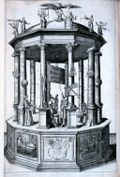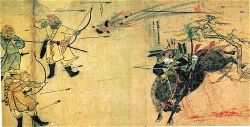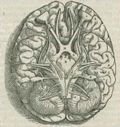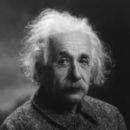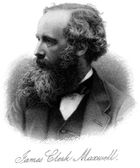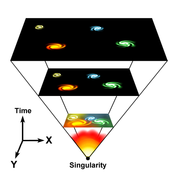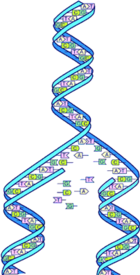History of science
2007 Schools Wikipedia Selection. Related subjects: British History; General Physics
| History of science |
| Background |
|---|
| Theories/sociology |
| Historiography |
| Pseudoscience |
| By era |
| In early cultures |
| in Classical Antiquity |
| In the Middle Ages |
| In the Renaissance |
| Scientific Revolution |
| By topic |
| Natural sciences |
| Astronomy |
| Biology |
| Chemistry |
| Ecology |
| Geography |
| Physics |
| Social sciences |
| Economics |
| Linguistics |
| Political science |
| Psychology |
| Sociology |
| Technology |
| Agricultural science |
| Computer science |
| Materials science |
| Medicine |
| Navigational pages |
| Timelines |
| Portal |
| Categories |
Science is a body of empirical and theoretical knowledge, produced by a global community of researchers, making use of specific techniques for the observation and explanation of real phenomena, this techne as a whole being summed up under the heading of scientific method. As such, the history of science draws on the historical methods of both intellectual history and social history.
The Scientific Revolution of the sixteenth and early seventeenth century saw the inception of modern scientific methods to guide the evaluation of knowledge. This change is considered to be so fundamental that some — especially philosophers of science and practicing scientists — consider such earlier inquiries into nature to be pre-scientific. Traditionally, historians of science have defined science sufficiently broadly to include those inquiries.
The history of mathematics, history of technology, and history of philosophy are covered in other articles. Mathematics is closely related to, but distinct from science (at least in the modern conception). Technology concerns the creative process of designing useful objects and systems, which differs from the search for empirical truth. Philosophy differs from science in that, while both the natural and the social sciences attempt to base their theories on established fact, philosophy also enquires about other areas of knowledge, notably ethics. In practice, each of these fields is heavily used by the others as an external tool.
Theories and sociology of the history of science
Much of the study of the history of science has been devoted to answering questions about what science is, how it functions, and whether it exhibits large-scale patterns and trends. The sociology of science in particular has focused on the ways in which scientists work, looking closely at the ways in which they "produce" and "construct" scientific knowledge. Since the 1960s, a common trend in the science studies (the study of the sociology and history of science) has been to emphasize the "human component" to scientific knowledge, and to de-emphasize the view that scientific data is self-evident, value-free, and context-free.
A major subject of concern and controversy in the philosophy of science has been to inquire about the nature of theory change in science. Three philosophers in particular who represent the primary poles in this debate have been Karl Popper, who argued that scientific knowledge is progressive and cumulative; Thomas Kuhn, who argued that scientific knowledge moves through " paradigm shifts" and is not necessarily progressive; and Paul Feyerabend, who argued that scientific knowledge is not cumulative or progressive, and that there can be no demarcation between science and any other form of investigation.
Since the publication of Kuhn's The Structure of Scientific Revolutions in 1962, there has been much debate in the academic community over the meaning and objectivity of "science." Often, but not always, a conflict over the "truth" of science has split along the lines of those in the scientific community and those in the social sciences or humanities (for example, the " Science wars").
Early cultures
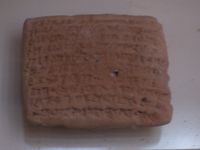
In prehistoric times, advice and knowledge was passed from generation to generation in an oral tradition. The development of writing enabled knowledge to be stored and communicated across generations with much greater fidelity. Combined with the development of agriculture, which allowed for a surplus of food, it became possible for early civilizations to develop, because more time could be devoted to tasks other than survival.
Many ancient civilizations collected astronomical information in a systematic manner through simple observation. Though they had no knowledge of the real physical structure of the planets and stars, many theoretical explanations were proposed.
Basic facts about human physiology were known in some places, and alchemy was practiced in several civilizations. Considerable observation of macrobiotic flora and fauna was also performed.
Science in Classical Antiquity

In Antiquity, the inquiry into the workings of the universe took place both in investigations aimed at such practical goals as establishing a reliable calendar or determining how to cure a variety of illnesses and in those abstract investegations known as natural philosophy. The ancient peoples who are considered the first scientists may have thought of themselves as natural philosophers, as practitioners of a skilled profession (for example, physicians), or as followers of a religious tradition (for example, temple healers).
The earliest Greek philosophers, known as the pre-Socratics, provided competing answers to the question found in the myths of their neighbors: "How did the ordered cosmos in which we live come to be?" Subsequently, Plato and Aristotle produced the first systematic discussions of natural philosophy, which did much to shape later investigations into nature.
The important legacy of this period included substantial advances in factual knowledge, especially in anatomy, zoology, and astronomy; an awareness of the importance of certain scientific problems, especially those related to the problem of change and its causes; and a recognition of the methodological importance of applying mathematics to natural phenomena and of undertaking empirical research.
Science in India
Indian philosophers in ancient India developed atomic theories, which included formulating ideas about the atom in a systematic manner and propounding ideas about the atomic constitution of the material world. The principle of relativity was also available in an early embryonic form in the Indian philosophical concept of "sapekshavad". The literal translation of this Sanskrit word is "theory of relativity" (not to be confused with Einstein's theory of relativity). The wootz, crucible and stainless steels were invented in India.
Aryabhata in 499 presented a heliocentric solar system of gravitation where he presented astronomical and mathematical theories in which the Earth was taken to be spinning on its axis and the periods of the planets were given as elliptical orbits with respect to the sun. He also believed that the moon and planets shine by reflected sunlight and that the orbits of the planets are ellipses. He carried out accurate calculations of astronomical constants based on this system, such as the periods of the planets, the circumference of the earth, the solar eclipse and lunar eclipse, the time taken for a single rotation of the Earth on its axis, the length of earth's revolution around the sun, and the longitudes of planets using eccentrics and epicycles. He also introduced a number of trigonometric functions (including sine, versine, cosine and inverse sine), trigonometric tables, and techniques and algorithms of algebra. Arabic translations of his texts were available in the Islamic world by the 8th-10th century.
In the 7th century, Brahmagupta briefly described the law of gravitation, and recognized gravity as a force of attraction. He also lucidly explained the use of zero as both a placeholder and a decimal digit, along with the Hindu-Arabic numerals now used universally throughout the world. Arabic translations of his texts (around 770) introduced this number system to the Islamic world, where it was adapted as Arabic numerals.
The Siddhanta Shiromani was a mathematical astronomy text written by Bhaskara in the 12th century. The 12 chapters of the first part cover topics such as: mean longitudes of the planets; true longitudes of the planets; the three problems of diurnal rotation; syzygies; lunar eclipses; solar eclipses; latitudes of the planets; risings and settings; the moon's crescent; conjunctions of the planets with each other; conjunctions of the planets with the fixed stars; and the patas of the sun and moon. The second part contains thirteen chapters on the sphere. It covers topics such as: praise of study of the sphere; nature of the sphere; cosmography and geography; planetary mean motion; eccentric epicyclic model of the planets; the armillary sphere; spherical trigonometry; ellipse calculations; first visibilities of the planets; calculating the lunar crescent; astronomical instruments; the seasons; and problems of astronomical calculations.
From the 12th century, Bhaskara and various Keralese mathematicians first conceived differential calculus, mathematical analysis, trigonometric series, floating point numbers, and concepts foundational to the overall development of calculus. By the end of the Middle Ages, iron rockets were developed in the kingdom of Mysore in South India.
Science in China
China has a long and rich history of technological contribution. The Four Great Inventions of ancient China (Chinese: 四大发明; Pinyin: Sì dà fā míng) are the compass, gunpowder, papermaking, and printing. These four discoveries had an enormous impact on the development of Chinese civilization and a far-ranging global impact. According to English philosopher Francis Bacon, writing in Novum Organum,
Printing, gunpowder and the compass: These three have changed the whole face and state of things throughout the world; the first in literature, the second in warfare, the third in navigation; whence have followed innumerable changes, in so much that no empire, no sect, no star seems to have exerted greater power and influence in human affairs than these mechanical discoveries." ( Novum Organum, Liber I, CXXIX - Adapted from the 1863 translation)
In regards to mathematics, two early works on mathematics were The Nine Chapters on the Mathematical Art (九章算術) (composed in the 1st century CE but perhaps as early as 200 BCE and the Suàn shù shū (discovered in a tomb from 186 BC, early in the Western Han dynasty). Most scholars believe that Chinese mathematics and the mathematics of the ancient Mediterranean world developed more or less independently up to the time when the Nine Chapters reached its final form. In the third century Liu Hui wrote his commentary on the Nine Chapters and also wrote Haidao suanjing which dealt with using Pythagorean theorem, which in China was known as Gougu theorem, to measure the size of things. In the fifth century the manual called "Zhang Qiujian suanjing" discussed linear and quadratic equations. By this point the Chinese had the concept of negative numbers. By the Tang Dynasty study of math was fairly standard in the great schools. The thirteenth century saw a renaissance in Chinese mathematical theory. This saw Chinese mathematicians solving equations with methods Europe would not know until the eighteenth century. The high point of this era came with Zhu Shijie's two books Suanxue qimeng and the Siyuan yujian. In one case he reportedly gave a method equivalent to Gauss's pivotal condensation. He also worked with a form of Pascal triangle in the thirteenth century, but called it "the ancient method of powers up to the eighth." Other discoveries include negative numbers, the binomial theorem, matrix methods for solving systems of linear equations, the Chinese remainder theorem, and the rule of three
Western academic thought on the history of Chinese technology and science was galvanized by the work of Joseph Needham and the Needham Research Institute. Among the scientific accomplishments of China were early seismological detectors, matches, the independent invention of the decimal system, dry docks, sliding calipers, the double-action piston pump, cast iron, the iron plough, the multi-tube seed drill, the wheelbarrow, the suspension bridge, the parachute, natural gas as fuel, , the raised-relief map, the propeller, the crossbow, a solid fuel rocket, and the cannon along with other contributions in logic, astronomy, medicine, and numerous other fields.
The Middle Ages
With the loss of the Western Roman Empire, much of Europe lost contact with the knowledge of the past. While the Byzantine Empire still held learning centers such as Alexandria and Constantinople, Western Europe's knowledge was concentrated in monasteries. The Library of Alexandria, which had suffered during and after the period of Roman rule, had been destroyed by 642, shortly after the Arab conquest of Egypt. Philosophical and scientific teaching of the period was based upon few copies and commentaries of ancient Greek texts that remained in Western Europe and the Middle East.
Islamic science
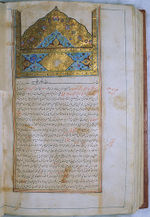
Meanwhile, in the Middle East, Greek philosophy was able to find some support by the newly created Arab Caliphate. With the spread of Islam in the 7th and 8th centuries, a period of Islamic scholarship lasted until the 14th century. This scholarship was aided by several factors. The use of a single language, Arabic, allowed communication without need of a translator. Access to Greek and Roman texts from the Byzantine Empire along with Indian sources of learning provided Islamic scholars a knowledge base to build upon. In addition, there was the Hajj, which facilitated scholarly collaboration by bringing together people and new ideas from all over the Islamic world.
Islamic scientists placed far greater emphasis on experiment than had the Greeks. In mathematics, the Persian scholar Muhammad ibn Musa al-Khwarizmi gave his name to the Indian concept of the algorithm, while the term algebra is derived from al-jabr, the beginning of the title of one of his publications. Sabian mathematician Al-Batani (850-929) contributed to astronomy and mathematics and Persian scholar Al-Razi to chemistry. In astronomy, Al-Batani improved the measurements of Hipparchus, preserved in the translation of the Greek Hè Megalè Syntaxis (The great treatise) translated as Almagest. Al-Batani also improved the precision of the measurement of the precession of the earth's axis. Arab alchemy, though flawed as a science, inspired Roger Bacon (who introduced the empirical method to Europe, strongly influenced by his reading of Arabic writers), and later Isaac Newton.
European science from the 12th century Renaissance
An intellectual revitalization of Europe started with the birth of medieval universities in the 12th century. The contact with the Islamic world in Spain and Sicily after the Reconquista and during the Crusades allowed Europeans access to preserved copies of the Ancient Greek and Roman works along with the works of Islamic philosophers, specially Averroes. The European universities aided materially in the translation and propagation of these texts and started a new infrastructure which was needed for scientific communities. As well as this, Europeans began to venture further and further east (most notably, perhaps, Marco Polo) as a result of the Pax Mongolica. This led to the increased influence of Indian and even Chinese science on the European tradition. Technological advances were also made, such as the early flight of Eilmer of Malmesbury (who had studied Mathematics in 11th century England), and the metallurgical achievements of the Cistercian blast furnace at Laskill.
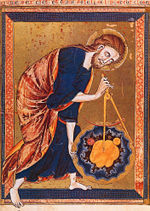
At the beginning of the 13th century there were reasonably accurate Latin translations of the main works of almost all the intellectually crucial ancient authors, allowing a sound transfer of scientific ideas via both the universities and the monasteries. By then, the natural philosophy contained in these texts began to be extended by notable scholastics such as Robert Grosseteste, Roger Bacon, Albertus Magnus and Duns Scotus. Precursors of the modern scientific method can be seen already in Grosseteste's emphasis on mathematics as a way to understand nature, and in the empirical approach admired by Bacon. According to Pierre Duhem, the Condemnation of 1277 led to the birth of modern science, because it forced thinkers to break from relying so much on Aristotle, and to think about the world in new ways.
The first half of the 14th century saw much important scientific work being done, largely within the framework of scholastic commentaries on Aristotle's scientific writings. William of Ockham introduced the principle of parsimony: natural philosophers should not postulate unnecessary entities, so that motion is not a distinct thing but is only the moving object and an intermediary "sensible species" is not needed to transmit an image of an object to the eye. Scholars such as Jean Buridan and Nicolas Oresme started to reinterpret elements of Aristotle's mechanics. In particular, Buridan developed the theory that impetus was the cause of the motion of projectiles, which was a first step towards the modern concept of inertia. The Oxford Calculators began to mathematically analyze the kinematics of motion, making this analysis without considering the causes of motion.
In 1348, the Black Death and other disasters sealed a sudden end to the previous period of massive philosophic and scientific development. Yet, the rediscovery of ancient texts was improved after the Fall of Constantinople in 1453, when many Byzantine scholars had to seek refuge in the West. Meanwhile, the introduction of printing (from China) was to have great effect on European society. The facilitated dissemination of the printed word democratized learning and allowed a faster propagation of new ideas. New ideas also helped to influence the development of European science at this point: not least the introduction of Algebra. These developments paved the way for the Scientific Revolution, which may also be understood as a resumption of the process of scientific change, halted at the start of the Black Death.
The Scientific Revolution
The renewal of learning in Europe, that began with 12th century Scholasticism, came to an end about the time of the Black Death, and the initial period of the subsequent Italian Renaissance is sometimes seen as a lull in scientific activity. The Northern Renaissance, on the other hand, showed a decisive shift in focus from Aristoteleian natural philosophy to chemistry and the biological sciences (botany, anatomy, and medicine). Thus modern science in Europe was resumed in a period of great upheaval: the Protestant Reformation and Catholic Counter-Reformation; the discovery of the Americas by Christopher Columbus; the Fall of Constantinople; but also the re-discovery of Aristotle during the Scholastic period presaged large social and political changes. Thus, a suitable environment was created in which it became possible to question scientific doctrine, in much the same way that Martin Luther and John Calvin questioned religious doctrine. The works of Ptolemy (astronomy), Galen (medicine), and Aristotle (physics) were found not always to match everyday observations. For example, an arrow flying through the air after leaving a bow contradicts Aristotle's laws of motion, which say that a moving object must be constantly under influence of an external force, as the natural state of earthly objects is to be at rest. Work by Vesalius on human cadavers also found problems with the Galenic view of anatomy.
The willingness to question previously held truths and search for new answers resulted in a period of major scientific advancements, now known as the Scientific Revolution. The Scientific Revolution is traditionally held by most historians to have begun in 1543, when De Revolutionibus, by the astronomer Nicolaus Copernicus, was first printed. The thesis of this book was that the Earth moved around the Sun. The period culminated with the publication of the Philosophiae Naturalis Principia Mathematica in 1687 by Isaac Newton.
Other significant scientific advances were made during this time by Galileo Galilei, Edmond Halley, Robert Hooke, Christiaan Huygens, Tycho Brahe, Johannes Kepler, Gottfried Leibniz, and Blaise Pascal. In philosophy, major contributions were made by Francis Bacon, Sir Thomas Browne, René Descartes, and Thomas Hobbes. The basics of scientific method were also developed: the new way of thinking emphasized experimentation and reason over traditional considerations.
Modern science
The Scientific Revolution established science as the preeminent source for the growth of knowledge. During the 19th century, the practice of science became professionalized and institutionalized in ways which would continue through the 20th century, as the role of scientific knowledge grew and became incorporated with many aspects of the functioning of nation-states.
Natural sciences
Physics
The Scientific Revolution is a convenient boundary between ancient thought and classical physics. Nicolaus Copernicus revived the heliocentric model of the solar system first devised by Aristarchus of Samos. This was followed by the first known model of planetary motion given by Kepler in the early 17th century, which proposed that the planets follow elliptical orbits, with the Sun at one focus of the ellipse. Also, Galileo pioneered the use of experiment to validate physical theories, a key idea in scientific method.
In 1687, Isaac Newton published the Principia Mathematica, detailing two comprehensive and successful physical theories: Newton's laws of motion, which lead to classical mechanics; and Newton's Law of Gravitation, which describes the fundamental force of gravity. The behaviour of electricity and magnetism was studied by Faraday, Ohm, and others during the early 19th century. These studies led to the unification of the two phenomena into a single theory of electromagnetism, by Maxwell (known as Maxwell's equations).
The beginning of the 20th century brought the start of a revolution in physics. The long-held theories of Newton were shown not to be correct in all circumstances. Beginning in 1900, Max Planck, Albert Einstein, Niels Bohr and others developed quantum theories to explain various anomalous experimental results, by introducing discrete energy levels. Not only did quantum mechanics show that the laws of motion did not hold on small scales, but even more disturbingly, the theory of general relativity, proposed by Einstein in 1915, showed that the fixed background of spacetime, on which both Newtonian mechanics and special relativity depended, could not exist. In 1925, Werner Heisenberg and Erwin Schrödinger formulated quantum mechanics, which explained the preceding quantum theories. The observation by Edwin Hubble in 1929 that the speed at which galaxies recede positively correlates with their distance, led to the understanding that the universe is expanding, and the formulation of the Big Bang theory by George Gamow.
Further developments took place during World War II, which led to the practical application of radar and the development and use of the atomic bomb. Though the process had begun with the invention of the cyclotron by Ernest O. Lawrence in the 1930s, physics in the postwar period entered into a phase of what historians have called " Big Science", requiring massive machines, budgets, and laboratories in order to test their theories and move into new frontiers. The primary patron of physics became state governments, who recognized that the support of "basic" research could often lead to technologies useful to both military and industrial applications. Currently, general relativity and quantum mechanics are inconsistent with each other, and efforts are underway to unify the two.
Chemistry
The history of modern chemistry can be taken to begin with the distinction of chemistry from alchemy by Robert Boyle in his work The Sceptical Chymist, in 1661 (although the alchemical tradition continued for some time after this) and the gravimetric experimental practices of medical chemists like William Cullen, Joseph Black, Torbern Bergman and Pierre Macquer. It can also be dated Antoine Lavoisier's naming of oxygen and the law of conservation of mass, which refuted phlogiston theory. Proof that all matter is made of atoms, which are the smallest constituents of matter that cannot be broken down without losing the basic chemical and physical properties of that matter, was provided by John Dalton in 1803. He also formulated the law of mass relationships. In 1869, Dmitri Mendeleev composed his periodic table of elements on the basis of Dalton's discoveries.
The synthesis of urea by Friedrich Wöhler opened a new research field, organic chemistry, and by the end of the 19th century, scientists were able to synthesize hundreds of organic compounds. The later part of the nineteenth century saw the exploitation of the Earth's petrochemicals, after the exhaustion of the oil supply from whaling. By the twentieth century, systematic production of refined materials provided a ready supply of products which provided not only energy, but also synthetic materials for clothing, medicine, and everyday disposable resources. Application of the techniques of organic chemistry to living organisms resulted in physiological chemistry, the precursor to biochemistry. The twentieth century also saw the integration of physics and chemistry, with chemical properties explained as the result of the electronic structure of the atom. Linus Pauling's book on The Nature of the Chemical Bond used the principles of quantum mechanics to deduce bond angles in ever-more complicated molecules. Pauling's work culminated in the physical modelling of DNA, the secret of life (in the words of Francis Crick, 1953). In the same year, the Miller-Urey experiment demonstrated in a simulation of primordial processes, that basic constituents of proteins, simple amino acids, could themselves be built up from simpler molecules.
Geology
Geology existed a cloud of isolated, disconnected ideas about rocks, minerals, and landforms long before it became a coherent science. Theophrastus' work on rocks Peri lithōn remained authoritative for millennia: its interpretation of fossils was not overturned until after the Scientific Revolution. Chinese polymath Shen Kua (1031 - 1095) was the first to formulate hypotheses for the process of land formation. Based on his observation of fossils in a geological stratum in a mountain hundreds of miles from the ocean, he deduced that the land was formed by erosion of the mountains and by deposition of silt.

Geology was not systematically restructured during the Scientific Revolution, but individual theorists made important contributions. Robert Hooke, for example, formulated theory of earthquakes, and Nicholas Steno developed the theory of superposition and argued that fossils were the remains of once-living creatures. Beginning with Thomas Burnet's Sacred Theory of the Earth in 1685, natural philosophers began to explore the idea that the Earth had changed over time. Burnet and his contemporaries interpreted Earth's past in terms of events described in the Bible, but their work laid the intellectual foundations for lsecular interpretations of Earth history.
Modern geology, like modern chemistry, gradually evolved during the 1700s and early 1800s. Benoit de Maillet and the Comte de Buffon argued that Earth was much older than the 6,000 years envisioned by biblical scholars. Jean-Etienne Guettard and Nicolas Desmarest hiked central France and recorded their observations on some of the first geological maps. Abraham Werner created a systemtic classifaction scheme for rocks and minerals--an achievement as significant for geology as that of Linnaeus was for biology. Werner also proposed a generalized interpretation of Earth history, as did contemporary Scottish polymath James Hutton. Georges Cuvier and Alexandre Brongniart, expanding on the work of Steno, argued that layers of rock could be dated by the fossils they contained: a principle first applied to the geology of the Paris Basin. The use of index fossils became a powerful tool for making geological maps, because it allowed geologists to correlate the rocks in one locality with those of similar age in other, distant localities. Over the first half of the nineteenth century, geologists such as Charles Lyell, Adam Sedgwick, and Roderick Murchison applied the new technique to rocks throughout Europe and eastern North America, setting the stage for more detailed, government-funded mapping projects in later decades.
Midway through the 19th century, the focus of geology shifted from description and classification to attempts to understand how the surface of the Earth changed. The first comprehensive theories of mountain building were proposed during this period, as were the first modern theories of earthquakes and volcanoes. Louis Agassiz and others established the reality of continent-covering ice ages, and "fluvialists" like Andrew Crombie Ramsay argued that river valleys were formed, over millions of years by the rivers that flow through them. Abraham Wegener's theory of "continental drift" was widely dismissed when it was proposed in the 1910s, but new data gathered in the 1950s and 1960s led to the theory of plate tectonics, which provided a plausible mechanism for it. Plate tectonics also provided a unified explanation for a wide range of seemingly unrelated geological phenomena. Since 1970 it has been the unifying principle in geology.
Geologists' embrace of plate tectonics was part of a broadening of the field from a study of rocks into a study of the Earth as a planet. Other elements of this transformation include: geophysical studies of the interior of the Earth, the grouping of geology with meteorology and oceanography as one of the "earth sciences," and comparisons of Earth and the solar system's other rocky planets.
Astronomy
Advances in astronomy and in optical systems in the 19th century resulted in the first observation of an asteroid (1 Ceres) in 1801, and the discovery of Neptune in 1846.
George Gamow, Ralph Alpher, and Robert Hermann had calculated that there should be evidence for a Big Bang in the background temperature of the universe. In 1964, Arno Penzias and Robert Wilson discovered a 3 kelvin background hiss in their Bell Labs radiotelescope, which was evidence for this hypothesis, and formed the basis for a number of results that helped determine the age of the universe.
Supernova SN1987A was observed by astronomers on Earth both visually, and in a triumph for neutrino astronomy, by the solar neutrino detectors at Kamiokande. But the solar neutrino flux was a fraction of its theoretically-expected value. This discrepancy forced a change in some values in the standard model for particle physics.
Biology, medicine, and genetics
In 1847, Hungarian physician Ignác Fülöp Semmelweis dramatically reduced the occurrency of puerperal fever by the simple experiment of requiring physicians to wash their hands before attending to women in childbirth. This discovery predated the germ theory of disease. However, Semmelweis' findings were not appreciated by his contemporaries and came into use only with discoveries by British surgeon Joseph Lister, who in 1865 proved the principles of antisepsis. Lister's work was based on the important findings by French biologist Louis Pasteur. Pasteur was able to link microorganisms with disease, revolutionizing medicine. He also devised one of the most important methods in preventive medicine, when in 1880 he produced a vaccine against rabies. Pasteur invented the process of pasteurization, to help prevent the spread of disease through milk and other foods.
Perhaps the most prominent and far-reaching theory in all of science has been the theory of evolution by natural selection put forward by the British naturalist Charles Darwin in his On the Origin of Species in 1859. Darwin's theory proposed that all differences in animals were formed by natural processes over long periods of time, and that even humans were simply evolved organisms. Implications of evolution on fields outside of pure science have led to both opposition and support from different parts of society, and profoundly influenced the popular understanding of "man's place in the universe". In the early 20th century, the study of heredity became a major investigation after the rediscovery in 1900 of the laws of inheritance developed by the Austrian monk Gregor Mendel in 1866. Mendel's laws provided the beginnings of the study of genetics, which became a major field of research for both scientific and industrial research. By 1953, James Watson and Francis Crick clarified the basic structure of DNA, the genetic material for expressing life in all its forms. In the late 20th century, the possibilities of genetic engineering became practical for the first time, and a massive international effort began in 1990 to map out an entire human genome (the Human Genome Project) has been touted as potentially having large medical benefits.
Ecology
The discipline of ecology typically traces its origin to the synthesis of Darwinian evolution and Humboldtian biogeography, in the late 19th and early 20th centuries. Equally important in the rise of ecology, however, were microbiology and soil science—particularly the cycle of life concept, prominent in the work Louis Pasteur and Ferdinand Cohn. The word ecology was coined by Ernst Haeckel, whose particularly holistic view of nature in general (and Darwin's theory in particular) was important in the spread of ecological thinking. In the 1930's, Arthur Tansley and others began developing the field of ecosystem ecology, which combined experimental soil science with physiological concepts of energy and the techniques of field biology. The history of ecology in the 20th century is closely tied to that of environmentalism; the Gaia hypothesis in the 1960s and more recently the scientific-religious movement of Deep Ecology have brought the two closer together.
Social sciences
Successful use of the scientific method in the physical sciences led to the same methodology being adapted to better understand the many fields of human endeavor. From this effort the social sciences have been developed.
Political science
While the study of politics is first found in the Western tradition in Ancient Greece, political science is a late arrival in terms of social sciences. However, the discipline has a clear set of antecedents such as moral philosophy, political philosophy, political economy, history, and other fields concerned with normative determinations of what ought to be and with deducing the characteristics and functions of the ideal state. In each historic period and in almost every geographic area, we can find someone studying politics and increasing political understanding.
The antecedents of politics trace their roots back even earlier than Plato and Aristotle, particularly in the works of Homer, Hesiod, Thucydides, Xenophon, and Euripides. Later, Plato analyzed political systems, abstracted their analysis from more literary- and history- oriented studies and applied an approach we would understand as closer to philosophy. Similarly, Aristotle built upon Plato's analysis to include historical empirical evidence in his analysis.
During the rule of Rome, famous historians such as Polybius, Livy and Plutarch documented the rise of the Roman Republic, and the organization and histories of other nations, while statesmen like Julius Caesar, Cicero and others provided us with examples of the politics of the republic and Rome's empire and wars. The study of politics during this age was oriented toward understanding history, understanding methods of governing, and describing the operation of governments.
With the fall of the Roman Empire, there arose a more diffuse arena for political studies. The rise of monotheism and, particularly for the Western tradition, Christianity, brought to light a new space for politics and political action. During the Middle Ages, the study of politics was widespread in the churches and courts. Works such as Augustine of Hippo's The City of God synthesized current philosophies and political traditions with those of Christianity, redefining the borders between what was religious and what was political. Most of the political questions surrounding the relationship between church and state were clarified and contested in this period.
In the Middle East and later other Islamic areas, works such as the Rubaiyat of Omar Khayyam and Epic of Kings by Ferdowsi provided evidence of political analysis, while the Islamic aristotelians such as Avicenna and later Maimonides and Averroes, continued Aristotle's tradition of analysis and empiricism, writing commentaries on Aristotle's works.
During the Italian Renaissance, Niccolò Machiavelli established the emphasis of modern political science on direct empirical observation of political institutions and actors. Later, the expansion of the scientific paradigm during the Enlightenment further pushed the study of politics beyond normative determinations. In particular, the study of statistics, to study the subjects of the state, has been applied to polling and voting.
Linguistics
Historical linguistics emerged as an independent field of study at the end of the 18th century. Sir William Jones proposed that Sanskrit, Persian, Greek, Latin, Gothic, and Celtic languages all shared a common base. After Jones, an effort to catalog all languages of the world was made throughout the 19th century and into the 20th century. Publication of Ferdinand de Saussure's Cours de linguistique générale spawned the development of descriptive linguistics. Descriptive linguistics, and the related structuralism movement caused linguistics to focus on how language changes over time, instead of just describing the differences between languages. Noam Chomsky further diversified linguistics with the development of generative linguistics in the 1950s. His effort is based upon a mathematical model of language that allows for the description and prediction of valid semantics. Additional specialties such as sociolinguistics, cognitive linguistics, and computational linguistics have emerged from collaboration between linguistics and other disciplines.
Economics
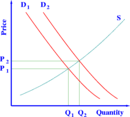
The basis for classical economics forms Adam Smith's An Inquiry into the Nature and Causes of the Wealth of Nations, published in 1776. Smith criticized mercantilism, advocating a system of free trade with division of labour. He postulated an " Invisible Hand" that large economic systems could be self-regulating through a process of enlightened self-interest. Karl Marx developed an alternative economical system, called Marxian economics. Marxian economics is based on the labor theory of value and assumes the value of good to be based on the amount of labor required to produce it. Under this assumption, capitalism was based on employeers not paying the full value of workers labor to create profit. The Austrian school responded to Marxian economics by viewing entrepreneurship as driving force of economic development. This replaced the labor theory of value by a system of supply and demand.
In the 1920s, John Maynard Keynes prompted a division between microeconomics and macroeconomics. Under Keynesian economics macroeconomic trends can overwhelm economic choices made by individuals. Governments should promote aggregate demand for goods as a means to encourage economic expansion. Following World War II, Milton Friedman created the concept of monetarism. Monetarism focuses on using the supply and demand of money as a method for controlling economic activity. In the 1970s, monetarism has adapted into supply-side economics which advocates reducing taxes as a means to increase the amount of money available for economic expansion.
Other modern schools of economic thought are New Classical economics and New Keynesian economics. New Classical economics was developed in the 1970s, emphasizing solid microeconomics as the basis for macroeconomic growth. New Keynesian economics was created partially in response to New Classical economics, and deals with how inefficiencies in the market create a need for control by a central bank or government.
Psychology
The end of the 19th century marks the start of psychology as a scientific enterprise. The year 1879 is commonly seen as the start of psychology as an independent field of study. In that year Wilhelm Wundt founded the first laboratory dedicated exclusively to psychological research (in Leipzig). Other important early contributors to the field include Hermann Ebbinghaus (a pioneer in memory studies), Ivan Pavlov (who discovered classical conditioning), and Sigmund Freud. Freud's influence has been enormous, though more as cultural icon than a force in scientific psychology.
The 20th century saw a rejection of Freud's theories as being too unscientific, and a reaction against Edward Titchener's atomistic approach of the mind. This led to the formulation of behaviorism by John B. Watson, which was popularized by B.F. Skinner. Behaviorism proposed epistemologically limiting psychological study to overt behaviour, since that could be reliably measured. Scientific knowledge of the "mind" was considered too metaphysical, hence impossible to achieve.
The final decades of the 20th century have seen the rise of a new interdisciplinary approach to studying human psychology, known collectively as cognitive science. Cognitive science again considers the mind as a subject for investigation, using the tools of evolutionary psychology, linguistics, computer science, philosophy, and neurobiology. New methods of visualizing the activity of the brain, such as PET scans and CAT scans, began to exert its influence as well. These new forms of investigation assume that a wide understanding of the human mind is possible, and that such an understanding may be applied to other research domains, such as artificial intelligence.
Sociology
Ibn Khaldun is regarded as the founder of modern sociology. As a scientific discipline, sociology emerged in the early 19th century as the academic response to the modernization of the world. Among many early sociologists (e.g., Émile Durkheim), the aim of sociology was in structuralism, understanding the cohesion of social groups, and developing an "antidote" to social disintegration. Max Weber was concerned with the modernization of society through the concept of rationalization, which he believed would trap individuals in an "iron cage" of rational thought. Some sociologists, including Georg Simmel and W. E. B. Du Bois, utilized more microsociological, qualitative analyses. This microlevel approach played an important role in American sociology, with the theories of George Herbert Mead and his student Herbert Blumer resulting in the creation of the symbolic interactionism approach to sociology.
American sociology in the 1940s and 1950s was dominated largely by Talcott Parsons, who argued that aspects of society that promoted structural integration were therefore "functional". This structural functionalism approach was questioned in the 1960s, when sociologists came to see this approach as merely a justification for inequalities present in the status quo. In reaction, conflict theory was developed, which was based in part on the philosophies of Karl Marx. Conflict theorists saw society as an arena in which different groups compete for control over resources. Symbolic interactionism also came to be regarded as central to sociological thinking. Erving Goffman saw social interactions as a stage performance, with individuals preparing "backstage" and attempting to control their audience through impression management. While these theories are currently prominent in sociological thought, other approaches exist, including feminist theory, post-structuralism, rational choice theory, and postmodernism.
Anthropology
Anthropology can best be understood as an outgrowth of the Age of Enlightenment. It was during this period that Europeans attempted systematically to study human behaviour. Traditions of jurisprudence, history, philology and sociology developed during this time and informed the development of the social sciences of which anthropology was a part.
At the same time, the romantic reaction to the Enlightenment produced thinkers such as Johann Gottfried Herder and later Wilhelm Dilthey whose work formed the basis for the culture concept which is central to the discipline. Traditionally, much of the history of the subject was based on colonial encounters between Europe and the rest of the world, and much of 18th- and 19th-century anthropology is now classed as forms of scientific racism.
During the late 19th-century, battles over the "study of man" took place between those of an "anthropological" persuasion (relying on anthropometrical techniques) and those of an " ethnological" persuasion (looking at cultures and traditions), and these distinctions became part of the later divide between physical anthropology and cultural anthropology, the latter ushered in by the students of Franz Boas.
In the mid-20th century, much of the methodologies of earlier anthropological and ethnographical study were reevaluated with an eye towards research ethics, while at the same time the scope of investigation has broadened far beyond the traditional study of "primitive cultures" (scientific practice itself is often an arena of anthropological study).
The emergence of paleoanthropology, a scientific discipline which draws on the methodologies of paleontology, physical anthropology and ethology, among other disciplines, and increasing in scope and momentum from the mid-20th century, continues to yield further insights into human origins, evolution, genetic and cultural heritage, and perspectives on the contemporary human predicament as well.
Emerging disciplines
During the 20th century, a number of interdisciplinary scientific fields have emerged. Three examples will be given here:
Communication studies combines animal communication, information theory, marketing, public relations, telecommunications and other forms of communication.
Computer science, built upon a foundation of theoretical linguistics, discrete mathematics, and electrical engineering, studies the nature and limits of computation. Subfields include computability, computational complexity, database design, computer networking, artificial intelligence, and the design of computer hardware. Computer science now typically distiniguishes itself by emphasising mathematical 'theory' in contrast to the practical emphasis of software engineering, but this theory refers to the mathematical foundations of computation, and relates little to the practice of programming or software design.
Materials science has its roots in metallurgy, minerology, and crystallography. It combines chemistry, physics, and several engineering disciplines. The field studies metals, ceramics, plastics, semiconductors, and composite materials.
